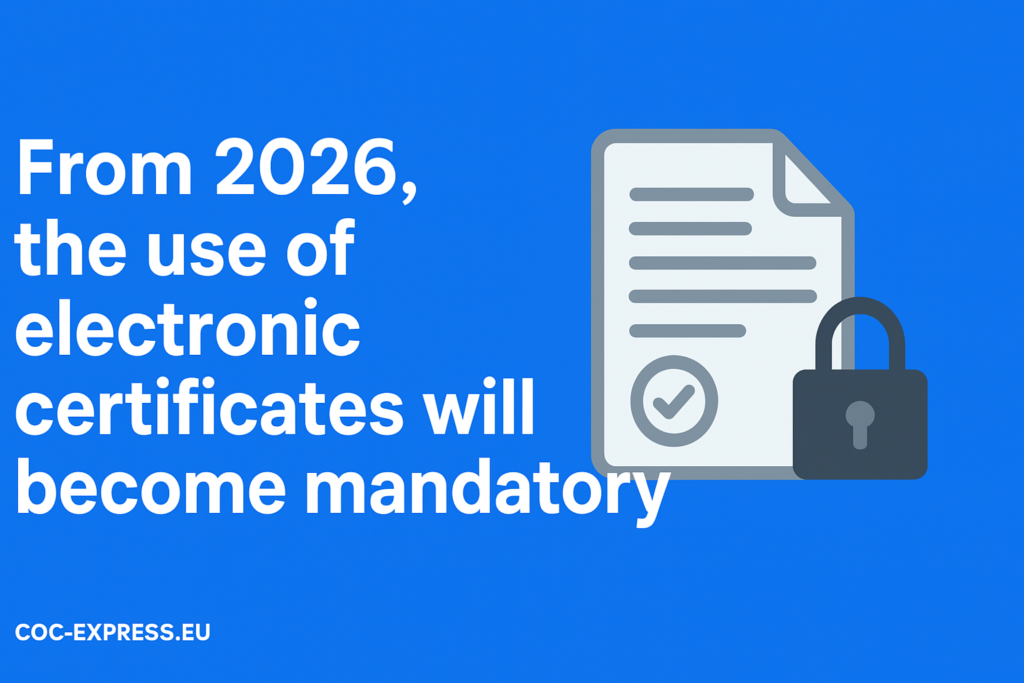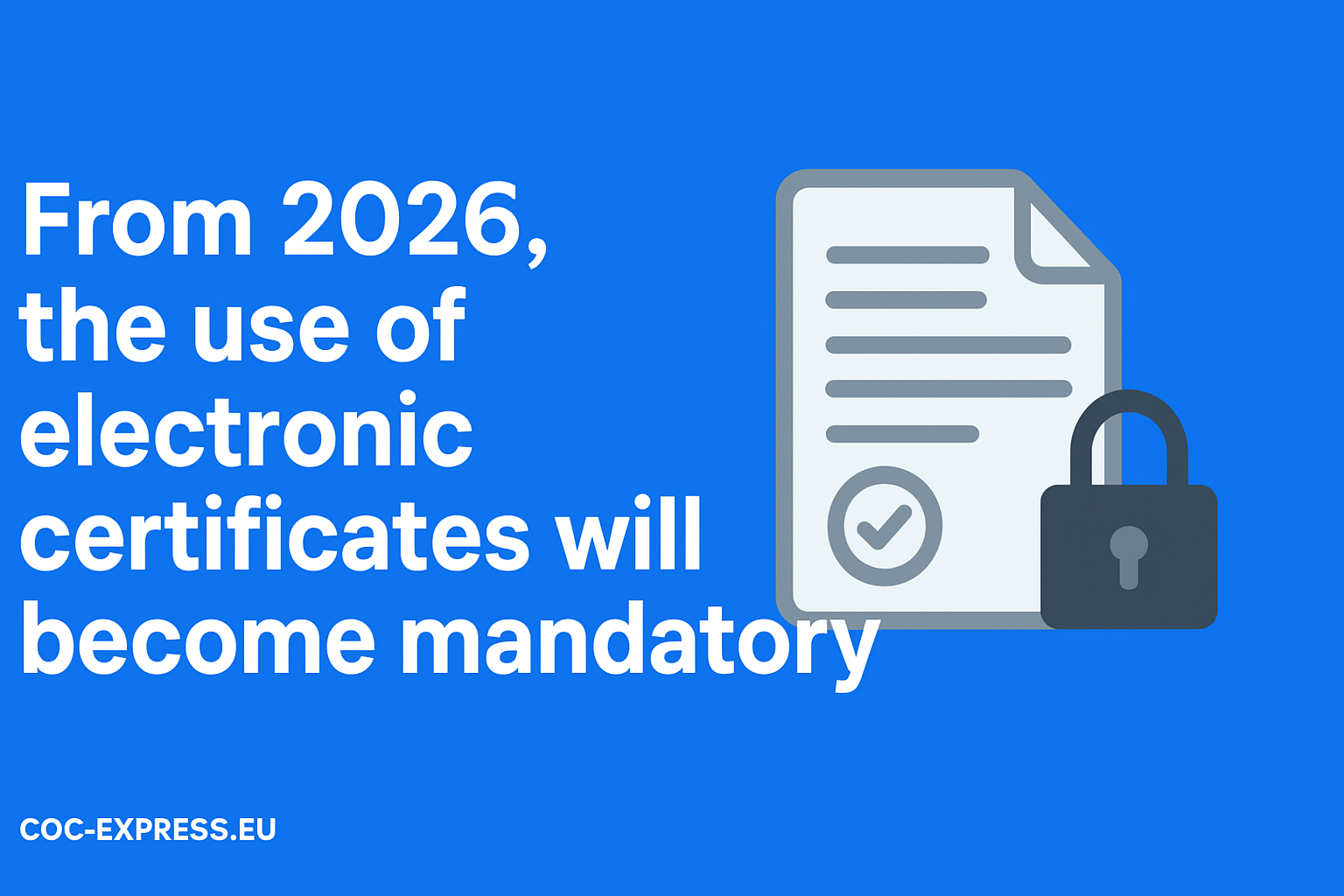Starting 5 July 2026, the European Union is making a major shift: Certificates of Conformity (CoCs) must be issued in electronic form by vehicle manufacturers for certain vehicle categories. Paper CoCs will no longer be sufficient in the usual course of business.
This will have significant implications for manufacturers, registrars, importers, dealers—and ultimately, vehicle owners. Here’s what you need to know & how to get ready.
What Is a Certificate of Conformity (CoC)?
A CoC is an official document provided by a vehicle manufacturer, certifying that an individual vehicle complies with the technical (safety, environmental, emissions) standards under EU type‐approval frameworks. It’s essential for vehicle registration in EU member states.
What’s Changing in 2026?
Under EU Regulation 2018/858 (and related implementing acts), from 5 July 2026:
- CoCs must be made available as structured data in electronic format (eCoC).
- Manufacturers must deliver the electronic CoC to the type‑approval authority that granted the Whole Vehicle Type Approval (WVTA) without unnecessary delay, and at no cost after the vehicle is produced.
- The eCoC data must be accessible to all relevant authorities: type‑approval authorities, registration authorities, market surveillance authorities in each member state.
Exceptions:
- Some vehicle categories (e.g. small series, or special categories like agricultural or towed equipment) may still allow paper CoCs under specific conditions.
- In exceptional cases, national competent authorities may still request paper duplicates, but the rule is firmly toward electronic as the norm.
Why the Shift to Electronic CoCs?
This move has many drivers:
- Efficiency & Cost Savings
Digital certificates reduce the administrative and logistical overhead of printing, mailing, handling, and storing paper documents. It also streamlines registration processes. - Accuracy & Data Quality
Structured electronic data helps reduce errors, enables automated validation, and improves traceability. Authorities can more easily verify compliance and detect discrepancies. - Harmonisation Across EU
A common electronic standard ensures consistency among member states. Registration across borders becomes smoother when all parties are working with the same digital formats and signatures. - Better Use of Technology
Secure electronic signatures, digital transmission, versioning, and centralized storage allow for more robust compliance, anti‑fraud, and auditing capabilities.
What Must Manufacturers & Importers Do to Prepare?
To comply with the new requirement, stakeholders should:
- Upgrade IT systems to generate CoCs in structured electronic format (usually XML), including tools for secure digital signatures that meet EU standards.
- Ensure integration with Type‑Approval Authorities and national registration authorities so that electronic CoCs can be transmitted and used without interruption.
- Train staff, set up internal workflows, version control, data integrity checks (e.g. ensuring no fields are missing, no format mismatches).
- Liaise with national authorities to understand any local transitional arrangements, exceptions, or processes (e.g. for small series vehicles or special categories) in their country.
- Plan for the possibility of issuing paper duplicates in exceptional cases, so that paper‑based fallback options exist as required.
What Happens If You Don’t Comply?
Failing to provide the required electronic CoC may lead to:
- Delays in vehicle registration (authorities may reject applications that lack valid eCoCs).
- Additional administrative costs (having to produce paper versions later or rectify missing/incorrect data).
- Potential legal or financial penalties, depending on member state rules.
Timeline Summary
| Date | Key Change |
|---|---|
| 5 July 2026 | eCoCs become mandatory for manufacturers of vehicles in categories M, N and their trailers (O), with paper CoC usable only in exceptional cases. |
| Before then | Time to adapt systems, workflows, train staff, work with authorities. |
| Post‑2026 | Increased harmonisation, reduced reliance on paper, smoother cross‑border registrations. |
How COC‑EXPRESS.EU Can Help You
At COC‑EXPRESS.EU, we’re committed to making this transition as smooth as possible for our clients. We can assist with:
- Supplying electronic CoC services that comply with EU regulation.
- Supporting manufacturers and importers with digital certificate generation, secure signing, and validated formats.
- Advisory services on legal compliance, local (country‑by‑country) requirements, and exception management.
- Integration tools to transmit CoC data to authorities in the required structured format.
Final Thoughts
The move to require electronic Certificates of Conformity from 2026 is not just a regulatory requirement—it’s a step toward modernisation, transparency, and efficiency in the EU automotive and regulatory ecosystem. While the transition poses challenges, those who prepare early will benefit from smoother operations, fewer delays, and better compliance.
If you’re a manufacturer, dealer, importer—or anyone involved in vehicle registration processes across the EU—now is the time to get ready. Need help with compliance or setting up your electronic CoC processes? Reach out to COC‑EXPRESS.EU for expert guidance.


